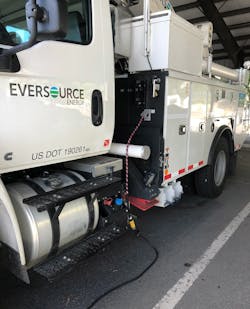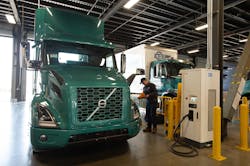Developing EV infrastructure: Fleet and dealer insights
The drive to field commercial electric vehicles by all types of fleets is steadily gaining speed and being fueled from all sides. There are initiatives and incentives from the government, sustainability pushes from major corporations, and heavy investments in development and testing from major truck manufacturers.
Everyone, it seems, is on board. At the same time, all these stakeholders agree that without much more widespread charging infrastructure, the timing for EV deployment remains uncertain.
How are shops determining EV charging infrastructure needs, evaluating charging systems and suppliers, and identifying installation and maintenance issues? When do they expect EV charging systems to be operational?
For answers to those and other questions, Fleet Maintenance turned to a fleet and a dealer who are focused on meeting EV charging system deployment challenges.
Fleet insights
As New England's largest energy provider, Eversource Energy seeks to accelerate the EV charging market, including deployment of both Level II and DC Fast Charging stations.
“We’re actively working with partners across the region to ensure that New England’s infrastructure can more broadly support the adoption of EVs, and we will continue adding charging stations at our own internal sites as necessary and as new vehicles arrive,” said Michael Rorison, Eversource director of fleet operations. “We constantly evaluate charging needs at our own facilities to support our evolving fleet, with solutions at our different sites tailored to the specifics of each location and the vehicles based there.”
Currently, 24% of the bucket trucks in the Eversource fleet have electric booms and the utility has set a goal to be at 100% by 2030. There are also 24 XL Hybrid trucks in the operation, and 25 pre-ordered Ford F-150 Lightning all-electric pickups should arrive next year.
“Eversource’s fleet maintenance operation is playing an important role in advancing the company’s goal of being carbon neutral, and we’ll be constantly evaluating how best to maximize the benefits of electric vehicles for our own fleet,” Rorison stated. “That will be a dynamic discovery process over the coming years. As we continue incorporating EV technologies in our own fleet, we’re learning from the programs we’ve already implemented.”
Dealer insights
As the largest Volvo Trucks North America dealership on the West Coast, TEC Equipment has many of these issues already figured out. Due to California’s emissions rules and overall push for electrification in the Golden State, TEC reported its fleet customers already show a high level of interest in electric trucks. In many cases, they are looking to get their first EVs into operation as soon as the economics allow.
Funding programs have accelerated this adoption rate in California in particular, TEC noted. The dealer has already deployed heavy-duty Volvo VNR Electric models and has placed additional orders for these electric regional haul trucks to be delivered over the next three quarters.
“We are actively quoting higher volumes of the VNR Electric, and there are other EV models on the horizon,” said Wayne Hammond, vice president, strategic initiatives. “Our larger fleet customers have generally been proactive in considering infrastructure needs to get on-site power requirements and EVSE (Electric Vehicle Supply Equipment) up and running concurrently with the delivery of the trucks. Currently, long lead times for utility work or the EVSE are putting some new installations three or four quarters out. In some cases, this timing could influence a fleet's EV deployment plan.”
Fleets need to work with their utility provider first, then identify a qualified electrical contractor and the actual EVSE that suits their operation, Hammond advised. In addition, the dealer can review with them the EVSE hardware options that are pre-approved by the OEM for interoperability with the truck.
Software is important for managing and reporting on EV energy use, and for calculating eligibility for low- and no-emission cap-and-trade credits. “Most EVSE includes software or is compatible with third-party software packages,” Hammond related. “Many turnkey providers can manage this entire process of hardware and software selection, utility planning, construction, and electrical site work.
“TEC’s Volvo Certified EV Dealership locations help customers work through this process to optimize their deployment,” Hammond continued. “Heavy-duty trucks require DC fast charging almost exclusively, so we generally limit our discussions to DC charging at 50kW or faster. The batteries and electric control systems on heavy-duty electric trucks are optimized for that type of charging system.”
The charging systems themselves generally require little maintenance, but like any software-driven hardware they are subject to occasional failure, Hammond also pointed out. To maximize uptime, TEC recommends choosing EVSE that includes an uptime service-level agreement as well as considering redundant configurations when suitable for the operation. For example, if operating schedules permit longer charging times for a small fleet, three 50kW chargers may be preferable to one 180kW charger.
“With appropriate shop tooling and technician training, TEC Equipment is servicing our EV customers much as we would any other customer, getting them in and out of the shop as quickly as possible,” Hammond stated. “Our Volvo Certified EV Dealership locations maintain moderate-wattage chargers in the shop and high-speed charging on the lot. The costs for us have been the EVSE, the utility and construction work, and minor reconfiguration of certain shop bays.
“The benefits are many,” Hammond added, “but a key one is helping take some of the complexity out of the EV transition, accelerating our customers’ readiness to go electric.”
EV charging solutions
The Alternative Fuels Data Center, a resource provided by the U.S. Department of Energy's Vehicle Technologies Office, gives the following keys to develop infrastructure for EV charging:
- An initial action in the charging infrastructure procurement process is to identify expected charging needs based on travel patterns, the amount of time it may take to charge the vehicle battery, and the number and type of EVs expected to be served at each location.
- Charging equipment is classified by the rate at which the batteries are charged. Charging times vary based on how much the battery is depleted, how much energy it holds, the type of battery, and the type of charging equipment.
- Another important consideration is to determine the cost associated with required charging needs. This includes equipment, installation, operation, and maintenance expenses.
- Equipment costs may vary based on factors such as application, location, charging level, and type. When choosing a charging infrastructure, consider available features such as networking capabilities, output power rating, the number and type of connectors, and the number of vehicles that can be charged simultaneously.
- Installation costs can vary based on the type of charging infrastructure, geographic location, site location and required trenching, existing wiring and required electrical upgrades, labor costs, and permitting.
- Federal, state, local, and utility incentives may be available to offset costs. Charging station installations must comply with local, state, and national codes and regulations, and be completed by a licensed electrical contractor.
Supplier guidance
XL Grid was launched to add charging and energy solutions to the XL Fleet lineup of electrified commercial vehicles. The offerings include a range of products and services through partnerships with hardware and software providers to develop a custom-designed charging infrastructure network that meets specific vehicle, utility, and application requirements.
ChargePoint has rolled out EV charging solutions for fleets of all types and sizes including the Express Plus (EXPP) DC fast charging platform, which consists of modular components (EXPP Power Block, EXPP Power Module, and EXPP Power Link) that can be configured to meet facility requirements and scale as fleets grow and the demand for EV charging increases. In addition, ChargePoint offers the CPF50 50-amp AC charging solution and an 80-amp AC charging solution for fleets.
About the Author

Seth Skydel
Seth Skydel, a veteran industry editor, has more than 36 years of experience in fleet management, trucking, and transportation and logistics publications. Today, in editorial and marketing roles, he writes about fleet, service, and transportation management, vehicle and information technology, and industry trends and issues.


